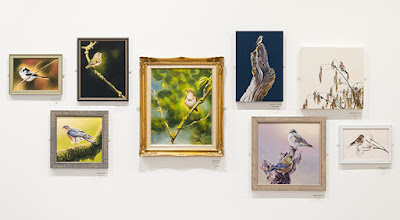by Amanda
Following on from Ros's evening listening to Nightingales, last week I found myself standing in the middle of a dark wood in drizzling rain, with boots soaked through to the socks, and with no idea which direction I'd entered the woods from and how I might be able to get out again. But that didn't matter - I was there to listen for Nightingales. Having never had the opportunity to hear their famed nightsong before, I wasn't about to let a little bit of rain stop me from getting the chance to listen to them at one of their yearly nesting sites. Nightingales sing around May to early June, so the window is short. Clad in hastily borrowed waterproof jacket and aforementioned unsuitable footwear, I joined Ros and a couple of other hopefuls for a dusk walk into the woodland at Glapthorn Cow Pastures near Oundle.
We arrived as the daylight was just beginning to fade. As we entered the woods, we were greeted with a symphony of birdsong. The trees rang with the bright songs of goodness knows how many species of bird, and it was very difficult to pick out one bird's song from another, especially for a novice like myself. After stopping to appreciate the sound for a while we moved on, reasoning that we might have a better chance of hearing the nightingales deeper in the woods.
Taking careful, quiet footsteps, we picked out a zigzagged pathway through the trees as the sky darkened, and the birdsong became sparser. We were collectively straining our ears for something that sounded that bit different - the rich, varied song that is so revered. The trouble was I had no real idea what I was listening for, other than knowing it ought to be something a bit special! My companions were a little more knowledgeable and so I trusted that they would recognise the tune of a Nightingale, once he made himself heard.
As we continued we heard snippets of what we thought might be Nightingales, but we could not be sure. The sound would come down from up the tallest trees as we stopped to listen, and we would only catch a few phrases, followed by a long silence that told us the bird had moved on. We stopped and started in this way for a good while, with me craning my head up towards the treetops in the hope I might see something. (As it turns out, all I saw were some crows and clumsy woodpigeons - Nightingales are secretive birds, and do not often allow themselves to be spotted.)
The fine rain had become a slightly heavier, persistent drizzle. My instinct was to put up my hood, but as soon as I did that I realised I couldn't hear much else other than my own boots in the grass. After a short while I took it down, deciding I'd rather get raindrops in my eyes and ears than risk muffling the sound of Nightingale song. As time went on we realised suddenly that all the birdsong had ceased. The woods had become completely silent.
Stepping gingerly, communicating only in occasional whispers, we carried on further into the eerily quiet woodland. And then we heard what we had been waiting for. Just as we were losing the last of the light, a single, clearly projected song came down from above; bursts of rapid and varied trills, with a rest between each phrase. We stopped to listen for a good five minutes before the bird moved on. From that point on we were treated several more times as we made our way through the darkness. The rain lent a lovely atmosphere to the evening; the gentle sound of light drops on the leaves above and the ground cover below a wonderful percussive accompaniment to the Nightingale's performance.
~
I have been working on a painting of a Nightingale which I have timed quite well - it is due to be completed very soon.
I'll share some pictures when it's done!

















